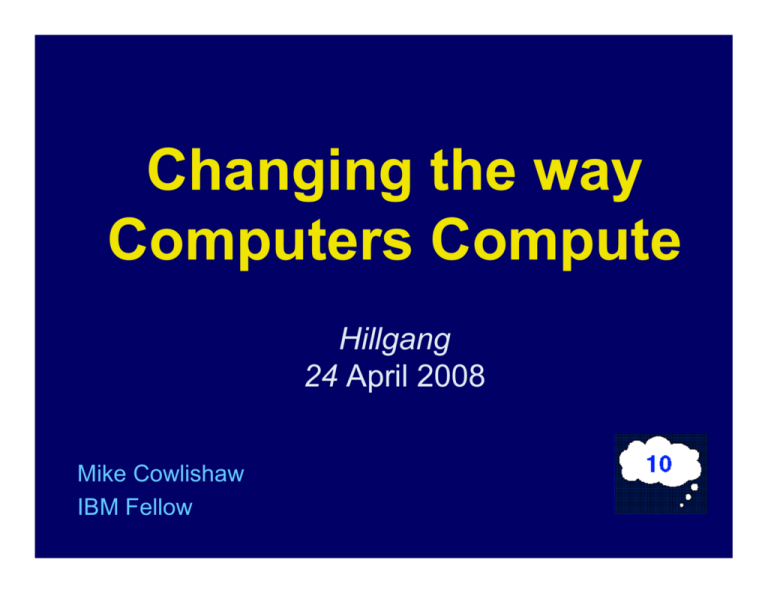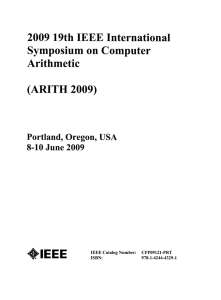
Changing the way
Computers Compute
Hillgang
24 April 2008
Mike Cowlishaw
IBM Fellow
Overview
• Why decimal floating-point (DFP)?
• DFP in System z and software
• Support in standards, etc.
• Using DFP in C and Java
• Questions?
Copyright © IBM Corporation 2008. All rights reserved.
2
Origins of decimal arithmetic
• Decimal (base 10) arithmetic has been
used for thousands of years
• Algorism (Indo-Arabic
place value system)
in use since 800 AD
• Calculators and many
computers were decimal …
3
IBM 650
(in Böblingen)
Bi-quinary digit
4
Binary computers
• In the 1950s binary floating-point was
shown to be more efficient
– minimal storage space
– more reliable (20% fewer components)
5
Today’s computer arithmetic
ALU
FPU
Integer
arithmetic
Floating-point
arithmetic
(IEEE 754)
byte, short, int,
long, etc.
single, float,
double, quad, etc.
6
Today’s computer arithmetic
ALU
FPU
12 x 12 → 144
1.2 x 1.2 → 1.44
byte, short, int,
long, etc.
single, float,
double, quad, etc.
7
1.2 x 1.2 = 1.44 ?
• binary fractions cannot exactly represent
most decimal fractions
0.1 in binary is 0.00011001100110011…
• 1.2 in a 32-bit binary float is actually:
1.2000000476837158203125
• and this squared is:
1.440000057220458984375
8
Why not just round ?
• Rounding hides but does not help
– obscures the slight inaccuracies
– errors accumulate [double rounding, too]
Decimal
9
0.9
0.09
0.009
Java float (binary)
9
0.9
0.089999996
0.009
9
Where it costs real money…
• Add 5% sales tax to a € 0.70 telephone
call, rounded to the nearest cent
• 1.05 x 0.70 using binary double is exactly
0.73499999999999998667732370449812151491641998291015625
(should have been 0.735)
• rounds to € 0.73, instead of € 0.74
10
Hence…
• Binary floating-point cannot be used for
commercial or human-centric applications
– cannot meet legal and financial requirements
• Decimal data and arithmetic are pervasive
• 55% of numeric data in databases are
decimal (and a further 43% are integers,
often held as decimal integers)
11
Why floating-point decimal?
• Traditional integer arithmetic with ‘manual’
scaling is awkward, error-prone, and very
hard to maintain
• Floating-point is increasingly necessary
–
–
–
–
interest calculated daily
telephone calls priced by the second
taxes more finely specified
financial analysis, etc.
12
Why decimal hardware?
Software is slow: typical JavaTM 1.4 BigDecimal
add is 1,708 cycles, hardware is ~ 12 cycles
software penalty
add
150x – 380x
quantize
60x – 140x
multiply
30x – 120x
divide
180x – 200x
penalty = Java 1.4 BigDecimal cycles ÷ DFPU clock cycles
13
Effect on real applications
• The ‘telco’ billing application
1,000,000 calls (two minutes)
read from file, priced, taxed,
and printed
Java†
C, C#
Itanium
BigDecimal packages hand-tuned
% execution
time in decimal
operations
93.2%
† Java 1.4
(Sun JVM)
72 – 78%
45% *
* IntelTM figure
14
The path to hardware…
• A 2 x (maybe more) performance
improvement in applications makes
hardware support ver y attractive
• Standard formats are essential for
language and hardware interfaces
– IEEE 754 is being revised (since 2001)
– incorporates IEEE 854 (radix-independent)
15
IEEE 754 agreed draft
(‘754r’)
• Now has decimal floating-point formats
(7, 16, and 34-digit) and arithmetic
– suitable for mathematical applications, too
• Fixed-point and integer decimal arithmetic
are subsets (no normalization)
• Compression maximizes precision and
exponent range of formats
16
IEEE 754r Formats
size (bits)
digits
exponent range
32
7
-95 to +96
64
16
-383 to +384
128
34
-6143 to +6144
(range always larger than
same-size binary format)
17
Integer-based floating-point
• Derived from Rexx decimal arithmetic
– adds Infinities and NaNs
– rounding modes (HALF_UP, HALF_EVEN,
TRUNCATE, etc.)
improved division: 2.40/2 gives 1.20
– fixed precision
– fixed (smaller) exponent range
– some subtle differences (edge effects, etc.)
–
18
IBM Decimal Hardware
• Power6 processor (2007) has a decimal
floating-point unit (DFPU) in hardware
– 54 instructions; registers shared with BFPU
– first commercial DFPU for 40 years
• System z9 (2007) – emulation with
hardware assists
• System z10 (Feb. 2008) hardware DFPU
19
Chart by Charles Webb 20
IBM Software
• Operating system enhancements
– AIX, Linux tools, z/OS, z/VM, i5/OS
• Languages
– Java, Language Environment (LE)
– XLC for z/OS, AIX, and Linux
– High Level Assembler, Enterprise PL/I
• DB2 Database (new DECFLOAT datatype)
– Available for z/OS, AIX, Linux, and Windows
21
Other standards, etc.
• Java 5 BigDecimal
– IBM JVM will use hardware if available
– no re-compile necessary
• C# and .Net ECMA and ISO standards
– arithmetic changed to match IEEE 754r, and
now allow use of 745r decimal128
• XML Schema 1.1 draft now has pDecimal
22
Other standards, etc.
[2]
• ISO C and C++ are jointly adding decimal
floating-point as first-class primitive types
• ECMAScript (JavaScript / JScript / ActionScript) is adding the decimal128 type
• Strong support expressed by SAP,
Microsoft, SHARE, academia, and many
others
23
Exploiting DFP in Java
• Java decimal processing is done using the
BigDecimal class
– used by JDBC (database interface), etc.
– arbitrary-length decimal arithmetic
• Greatly enhanced in Java 5 to match IEEE
754r arithmetic (except Infinities and NaNs)
• Added new MathContext class to set sizes
24
Java BigDecimal Add
• Cannot simply use ‘+’ (yet):
BigDecimal a = new BigDecimal(“1.27”);
BigDecimal b = new BigDecimal(“1.23”);
BigDecimal c = a.add(b);
System.out.println(c);
2.50
25
Java MathContext
• Sets a size (and rounding mode) to match
hardware size (16 digits):
MathContext mc = MathContext.DECIMAL64;
BigDecimal c = a.divide(b, mc);
System.out.println(c);
1.032520325203252
26
Java DFP hardware support
• The hardware support in the JIT saves
values in hardware format if they fit
• Operations use hardware if possible, and
keep results in hardware format if they fit
– almost always fit if MathContext.DECIMAL64
is used
• In Java 5 SR3; enabled by command-line
option: -Xbddfp
27
Using DFP in C
• Option A: packages to use with existing
compilers
– decNumber (includes decFloats)
• Option B: new compilers which support
DFP as native datatypes
– Gnu (GCC)
– IBM XLC for z/OS
28
decNumber C package
• Arbitrary-precision decimal package
– includes the hardware formats but does not
use hardware
– also converts to / from strings and BCD
• Open source cross-platform ANSI C
– very free licence
– matches hardware results exactly
– available since 2003, look for it at:
http://www2.hursley.ibm.com/decimal
29
decFloats C package
• Fixed-precision decimal package
– computes directly on the new IEEE 754r
decimal formats
– often 2–3 times faster than decNumber
• Open source cross-platform ANSI C
– very free licence
– included in the decNumber package, at:
http://www2.hursley.ibm.com/decimal
30
Gnu C Compiler (GCC)
• Open source C compiler for Linux, etc.
• Includes the proposed ISO C decimal types
(since GCC 4.2)
– uses decFloats for decimal arithmetic when no
hardware available
– hardware code generation is in GCC 4.3,
shipped in Suse SLES 11 and Red Hat RHEL
6; the option to use the instructions is
–march=z9-ec
31
Performance expectations
• Java:
– JIT approach has overheads, so will not help
trivial applications very much (e.g., adding
a column of aligned numbers)
– biggest improvement is using MathContext
when rounding (and for divisions, etc.)
• C packages are quite fast
• C compilers exploit full hardware speed
32
Benefits of the new types
• Hardware performance:
– individual operations can be 150x faster
than Java 1.4 and 10x–50x faster than C
packages
– applications may be 2x faster
– almost all commercial and financial
applications will get a performance boost
33
Benefits of the new types
[2]
• Standard data types for decimal bring all
the benefits that binary applications enjoy:
– known, standard, formats, so no conversions
(less checking needed at interfaces)
– faster processing (especially with hardware)
– well-defined arithmetic, rounding rules, etc.
– safer and easier-to-write applications
– long-term: single numeric type (no binaries)
34
Questions?
Google: general decimal arithmetic
35
36
Format details
37
IEEE 754r: common ‘shape’
Sign Comb. field Exponent
•
Coefficient
Sign and combination field fit in first byte
– combination field (5 bits) combines 2 bits of
the exponent (0−2), first digit of the coefficient
(0−9), and the two special values
– allows ‘bulk initialization’ to zero, NaNs, and
± Infinity by byte replication
38
Exponent continuation
Coefficient
Sign Comb. field Exponent
Simple concatenation
exponent
Format
bits
bias
normal range
32-bit
2+6
101
-95 to +96
64-bit
2+8
398
-383 to +384
128-bit
2+12
6176
-6143 to +6144
(All ranges larger than binary in same format.)
39
Coefficient continuation
Sign Comb. field Exponent
Coefficient
•
Densely Packed Decimal – 3 digits in
each group of 10 bits (6, 15, or 33 in all)
•
Derived from Chen-Ho encoding, which
uses a Huffman code to allow expansion
or compression in 2–3 gate delays
40
41


